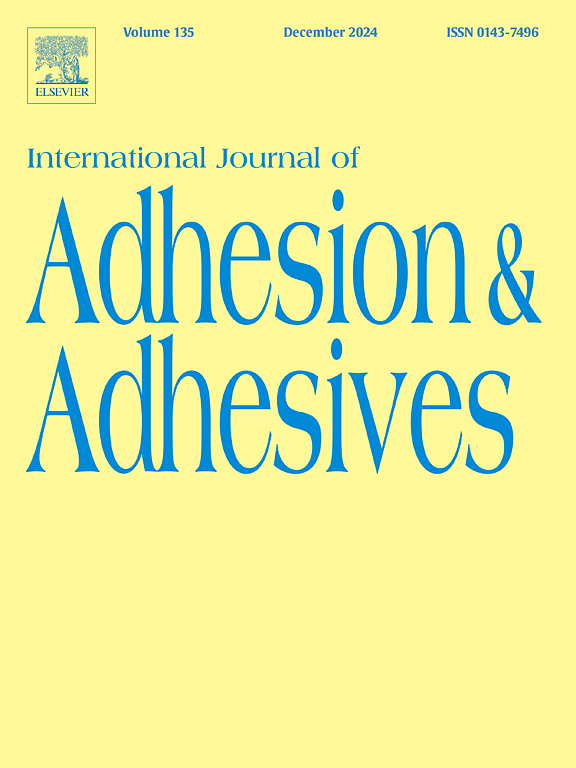Multiscale investigation on enhancing the adhesion properties of SFP materials through interfacial modification
IF 3.5
3区 材料科学
Q2 ENGINEERING, CHEMICAL
International Journal of Adhesion and Adhesives
Pub Date : 2025-07-19
DOI:10.1016/j.ijadhadh.2025.104108
引用次数: 0
Abstract
Semi-flexible pavements (SFP) are composite structures that combine flexibility and rigidity, ensuring high load-bearing capacity and enhanced durability. However, their performance in practical application largely depends on the adhesion between asphalt and cement-based grout, which remains a challenge in practical applications. This paper proposes an interfacial immersion method using a silane coupling agent to enhance the adhesion properties of SFP. To enhance the adhesion property of SFP, an interfacial immersion method is proposed in this paper. A multiscale investigation on improving the adhesion property of SFP material using interfacial modification. Firstly, pull-off tests were conducted to assess the adhesion properties of SFP at the macroscale, considering grout materials of different strengths and aggregates with varying characteristics under interfacial modification. Secondly, contact angle tests were performed to analyze changes in the surface free energy of the asphalt interface in SFP at the mesoscale. Finally, atomic force microscopy (AFM) was utilized to evaluate the adhesion performance of the asphalt interface in SFP at the microscale after interfacial modification. Experimental results show that the proposed method significantly enhances the adhesion properties of SFP, with bond strength increasing by up to 165.6 % in SFP formed with alkaline aggregates. After immersion in a silane coupling agent solution, micro-protrusions form on the asphalt surface, increasing contact area and creating a modification layer that strengthens adhesion. Surface free energy rises by 39.79 %, improving wettability and molecular interactions. Additionally, dissipated energy increases, enhancing stress relaxation capacity and low-temperature performance due to improved surface polarity, roughness, and viscoelasticity of the modified layer. The research results can provide an insight into interface engineering for SFP, offering a practical approach to improving pavement performance through targeted interface modification.

通过界面改性提高SFP材料粘附性能的多尺度研究
半柔性路面(SFP)是一种结合柔性和刚性的复合结构,可确保高承载能力和增强耐久性。然而,它们在实际应用中的性能在很大程度上取决于沥青与水泥基浆液之间的粘附性,这在实际应用中仍然是一个挑战。本文提出了一种采用硅烷偶联剂界面浸渍的方法来提高SFP的粘接性能。为了提高SFP的粘接性能,本文提出了一种界面浸渍法。用界面改性提高SFP材料粘接性能的多尺度研究。首先,考虑不同强度的灌浆材料和不同特性的集料在界面改性下的粘附性能,进行了宏观尺度的拉脱试验,评估了SFP的粘附性能。其次,通过接触角试验分析了SFP中沥青界面表面自由能的中尺度变化。最后,利用原子力显微镜(AFM)在微观尺度上评价了SFP中沥青界面改性后的粘附性能。实验结果表明,该方法显著提高了SFP的粘接性能,与碱性聚集体形成的SFP的粘接强度提高了165.6%。在硅烷偶联剂溶液中浸泡后,沥青表面形成微突起,增加了接触面积,形成了增强附着力的改性层。表面自由能提高了39.79%,改善了润湿性和分子间的相互作用。此外,由于改进了改性层的表面极性、粗糙度和粘弹性,耗散能量增加,增强了应力松弛能力和低温性能。研究结果为SFP的界面工程提供了新的思路,为通过有针对性的界面改造改善路面性能提供了切实可行的途径。
本文章由计算机程序翻译,如有差异,请以英文原文为准。
求助全文
约1分钟内获得全文
求助全文
来源期刊

International Journal of Adhesion and Adhesives
工程技术-材料科学:综合
CiteScore
6.90
自引率
8.80%
发文量
200
审稿时长
8.3 months
期刊介绍:
The International Journal of Adhesion and Adhesives draws together the many aspects of the science and technology of adhesive materials, from fundamental research and development work to industrial applications. Subject areas covered include: interfacial interactions, surface chemistry, methods of testing, accumulation of test data on physical and mechanical properties, environmental effects, new adhesive materials, sealants, design of bonded joints, and manufacturing technology.
 求助内容:
求助内容: 应助结果提醒方式:
应助结果提醒方式:


